Benjamin Moore's 2022 Color of the Year: Insights and Trends
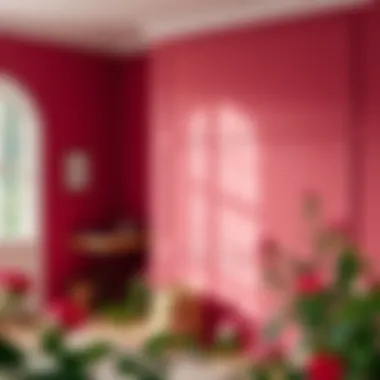
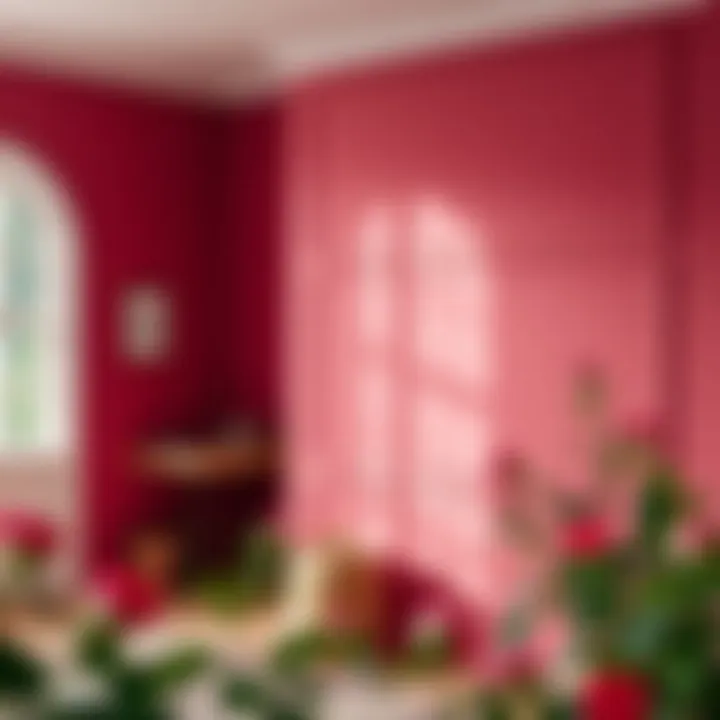
Intro
As the world of design continuously evolves, color choice plays a crucial role in shaping our environments. Benjamin Moore's Color of the Year for 2022 carries significant weight, not only for homeowners but also for interior designers looking to make a statement. The selected hue is more than just paint on the walls; it embodies a philosophy and a way of thinking that influences trends and individual tastes.
Through this analysis, we aim to unpack the deeper implications behind the color. We’ll explore its inspiration, relevance within current design trends, and the psychological effects it can impart on living spaces. For those looking to revitalize their interiors or simply gain a better understanding of the color's impact, this information will prove invaluable.
Design Inspiration
The initiation of any design project often revolves around a key color that sets the stage for creativity. The Color of the Year from Benjamin Moore not only reflects current tastes but also predicts future trends. Let's dive into what inspired this choice and how it resonates in today’s aesthetic landscape.
Trending Styles and Themes
In recent years, there's been a noticeable shift toward sustainability and biophilic design. The Color of the Year aligns with these themes, drawing inspiration from nature and bringing the outdoors inside. This choice is not merely trend-driven; it signals a growing desire for authenticity and connection to our environment.
- Natural Elements: Deep greens and earthy tones are on the rise. These shades instill a sense of tranquility and serve as a reminder of the serenity found in nature.
- Minimalism Meets Warmth: While minimalist styles dominate, there’s a push for warmth through color, creating spaces that feel inviting and lived-in. The Color of the Year achieves this balance gracefully, avoiding the sterile feel sometimes associated with minimalism.
Color Palettes and Combinations
When it comes to integrating this color into your home, understanding which shades complement it is paramount. Here are a few harmonious pairings to consider:
- Accent Walls: Using the Color of the Year as an accent wall, paired with soft whites or muted beiges can bring a sophisticated edge to your space.
- Bold Contrasts: For those who prefer a vibrant aesthetic, contrasting it with jewel tones such as sapphire blue or ruby red can create an eye-catching vitality to your rooms.
- Earthy Neutrals: Shades like taupe, sand, or olive can act as a pleasing backdrop, allowing the Color of the Year to stand out without competing for attention.
In essence, knowing how to mix and match this color can transform your home, making it more than just visually appealing but also grounding and harmonious.
"Color is the keyboard, the eyes are the harmonies, the soul is the piano with many strings." - Wassily Kandinsky
This famous quote perfectly encapsulates the relationship we forge with colors. They not only influence our visual experience but also connect us emotionally.
In the upcoming sections, we will dive deeper into the psychology behind the chosen shade and how it can be applied in different settings, ensuring that our spaces reflect not only trends but also our inner selves.
Overview of Benjamin Moore's Color Selection Process
Understanding how Benjamin Moore curates its Color of the Year can offer valuable insights to homeowners and design enthusiasts alike. The selection process is more than just a trend indicator; it serves as a reflective mirror of societal values and lifestyle shifts. With every stroke of the brush, the chosen color encapsulates the collective mood of a year, acting as both a guide and a catalyst for design choices.
Preamble to the Color of the Year
Benjamin Moore's approach to selecting its Color of the Year is a thoughtful endeavor that combines creativity with cultural reflection. Each year, a group of experts within the organization analyzes emerging trends, color forecasts, and societal changes to arrive at a hue that resonates universally. This deliberation seeks to connect color choices with contemporary human experiences, emphasizing harmony and balance within living spaces.
The color selection is not arbitrary; it reflects trends in design that resonate across various platforms, from interior decor to fashion. For instance, in 2022, the chosen hue may embody a sense of calmness and renewal, mirroring the world's yearning for tranquility in post-pandemic life. Homeowners can take comfort in knowing that their color choices are steeped in thoughtful analysis and societal context.
Historical Context of Color Choices
To truly appreciate the significance of the Color of the Year, it’s essential to reflect on how colors have evolved over the decades. Historically, colors have often been linked to movements, cultural sentiments, and even political climates.
- Early 20th Century: Colors like soft pastels emerged during the post-war era, symbolizing hope and renewal after the hardships of war.
- Mid-Century Modern: Bright and bold shades marked this era, aligning with the growing consumerism and optimism of the post-war boom.
- 2000s Onwards: As design became more eclectic, colors reflected personal expression rather than strict adherence to trends.
Today, Benjamin Moore’s Color of the Year continues that legacy, but with a modern twist. It is not just about attracting attention; rather, it concerns embracing emotions that can soothe or invigorate. Each year’s selection is a dialogue amongst past influences and contemporary outlooks, creating a layered understanding of why certain colors are favored at specific times.
"Colors serve as vibrant milestones, coding the emotional landscape of each era."
As we delve deeper into the implications of the Color of the Year for 2022, it becomes evident that it represents far more than mere preference; it signifies a profound connection to our evolving world.
The Color of the Year
Choosing a Color of the Year is no small feat, especially for a company like Benjamin Moore, which has established itself as a thought leader in paint and color trends. The selection is not merely about picking a pretty shade; it reflects broader cultural and design movements, making it crucial for homeowners and designers alike.
This year, the chosen color resonates deeply with current values such as sustainability, wellness, and individual expression. Understanding the intricacies of this color involves dissecting its characteristics and how it can be utilized in different spaces. This understanding is essential for anyone looking to refresh their interiors in a meaningful way.
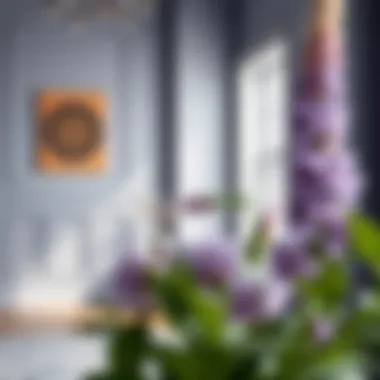
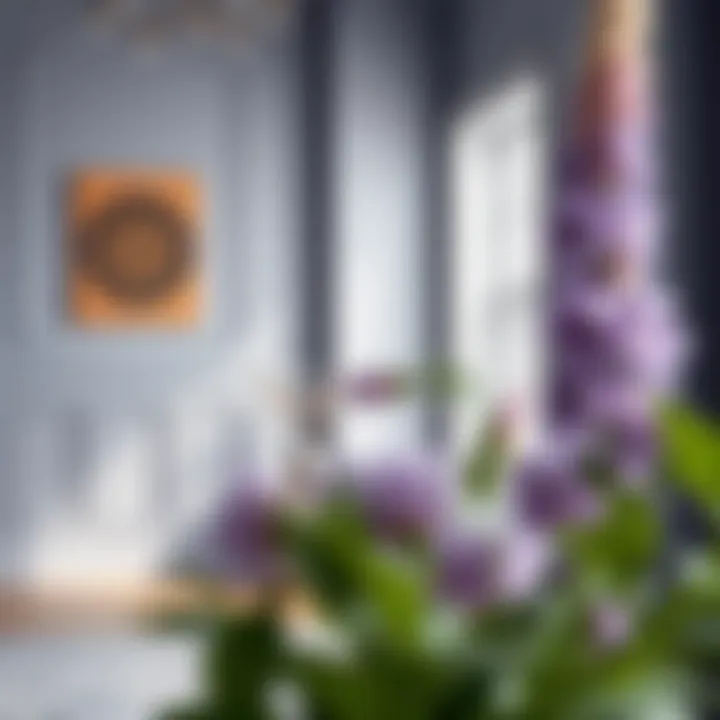
Description and Characteristics
The Color of the Year 2022 is known for its versatility and vibrancy. It embodies both warmth and depth, making it suitable for various settings. Users often report feeling energized and uplifted by the hue, indicating its potential impact on mood and aesthetics. The choice encapsulates a balance that evokes a sense of togetherness while supporting a spirit of individuality, thus making it a favorable option for modern homes.
Incorporating the Color into Interior Design
Living Spaces
When it comes to living spaces, this color introduces a lively yet calming atmosphere, promoting relaxation and connection. Its resonance within communal areas fosters conversations and gatherings, making it a favored choice for many homeowners.
A unique feature of this color in living spaces is its ability to harmonize with a variety of furnishings and textures, from plush sofas to minimalist decor. For those eager to create a cozy yet sophisticated environment, it's a smart choice that can tie together diverse elements within a home. However, careful selection of coordinating colors is essential to prevent overwhelming the space.
Kitchens and Dining Areas
The application of the Color of 2022 in kitchens and dining areas showcases its practicality and charm. This color tends to evoke warmth, making it ideal for family gatherings and dinner parties.
Highlighting the kitchen's unique feature of being a hub of activity, the chosen hue can enhance social interactions, creating an inviting atmosphere where culinary creativity thrives. A beneficial aspect of using this color here is its compatibility with various kitchen styles, from rustic farmhouse to sleek modern. One might find that balancing it with lighter tones leads to a more expansive feel, while darker tones create intimacy, but the trick is not to overshadow the cooking features.
Bedrooms and Bathrooms
For bedrooms and bathrooms, the Color of the Year brings a sense of tranquility and rejuvenation, two characteristics that are invaluable in personal spaces. This specific hue supports relaxation, particularly in bedrooms, where calm is paramount.
Its soothing quality can transform a space into a sanctuary. A major advantage of implementing this color in bathrooms is that it can make these areas feel more spa-like. Potential downsides, however, include the risk of making a small space feel even smaller if not complemented correctly. Therefore, a careful approach to integrating this shade is critical to maintain an airy and light atmosphere.
"The Color of the Year is a reflection of our times and gives insight into the overall trends shaping design decisions in homes and spaces." - Benjamin Moore Marketing Team
The Philosophical Implications of Color Choices
The act of choosing a color for a space goes beyond mere aesthetics; it taps into a rich tapestry of philosophy and psychology that informs our perceptions and interactions with our environments. In this section, we will delve into the profound significance of color, particularly in relation to Benjamin Moore's Color of the Year 2022. Understanding the implications behind color selection not only enhances one's appreciation for design but also equips homeowners and enthusiasts with the tools to create spaces that resonate on a deeper emotional level.
Symbolism and Meaning
Colors are laden with symbolism, often reflecting cultural narratives and personal experiences. Each hue carries its own connotation, influencing moods and behaviors. For instance, greens often evoke feelings of tranquility and renewal, while blues are associated with calmness and reliability.
In the context of Benjamin Moore’s 2022 Color of the Year, the choice represents a dialogue between contemporary aesthetics and traditional meanings. It resonates with the notion of rebirth, akin to the fresh start that warm weather brings after a long winter. This philosophical approach to color can be understood through several lenses:
- Cultural Symbolism: Different cultures attribute unique meanings to colors. In some traditions, red denotes luck, while in others, it might symbolize danger. Being aware of these nuances allows for an informed application of color that respects cultural significance.
- Personal Resonance: People often gravitate toward colors that resonate with their life experiences. For example, a vibrant orange might conjure pleasant memories of family gatherings during autumn harvests.
- Psychological Impact: Colors can trigger emotional responses. For instance, consider how a soft lavender can instill peace after a stressful day, compared to a bright yellow that can elevate one's energy and creativity.
Understanding these elements allows designers and homeowners to intentionally manipulate their spaces through color, fostering an environment that is not only visually appealing but also deeply meaningful.
Cultural Influences on Color Perception
To grasp how colors are perceived across various cultures is to uncover a fascinating aspect of human psychology. Color preferences and interpretations are shaped by historical, sociological, and environmental factors. This is particularly evident when examining the influence of geography and lifestyle on color choices.
- Regional Differences: In colder climates, for example, warmer colors may be favored to add warmth to interiors, while coastal regions might incline towards cooler, earthy tones to echo the surrounding landscape.
- Historical Context: The history of color usage also plays a significant role. For example, the use of certain shades may have changed over time due to advancements in technology or shifts in societal values.
- Consumer Trends: As society evolves, so too do color trends. The popularity of sustainable living has seen an uptick in earthy colors that reflect an eco-conscious mindset.
Cultural influences provide a fascinating lens through which to view color choices, making it vital for designers to remain culturally literate and sensitive to the meanings that specific colors might carry within a given context. Exploring these philosophical realms allows for a more nuanced understanding and application of color in interior design, ensuring that every shade contributes thoughtfully to the narrative of a space.
"Colors are the smiles of nature; they coax joy and articulate emotions in various forms."
By embracing these philosophical implications, one can create surroundings that elevate the experience of living spaces and foster a profound connection to the environment.
Psychological Effects of Color on Mood and Environment
When discussing the significance of colors in our lives, it becomes apparent that hues can do much more than beautify a room. They can evoke emotions, trigger memories, and even influence our daily behavior. In the context of Benjamin Moore's Color of the Year for 2022, analyzing the psychological impact of color plays a crucial role in understanding how this specific shade can transform our living environments.
Understanding Color Psychology
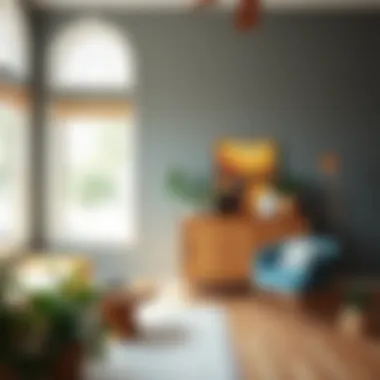
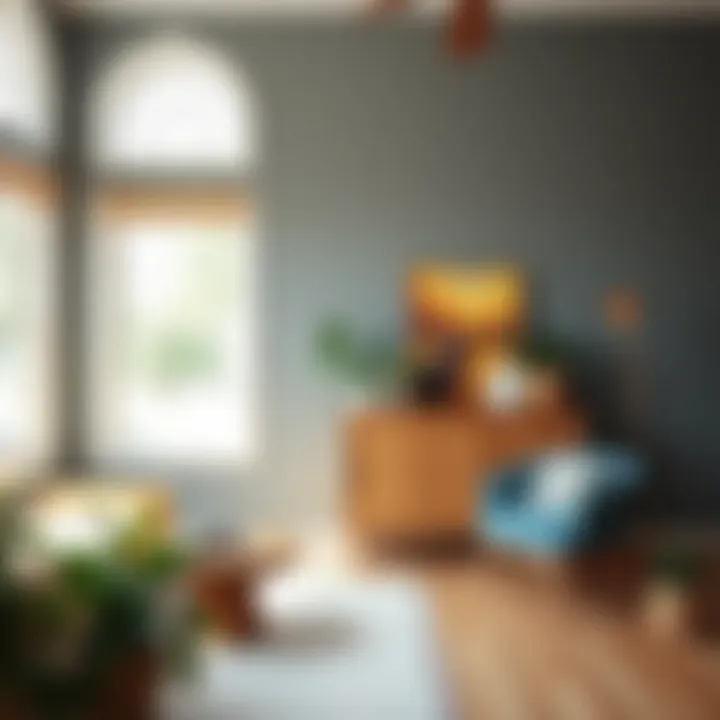
Color psychology is the study of how colors affect our emotions and behaviors. Different shades can symbolize various feelings; for instance, blue often represents calmness, while yellows can invoke a sense of joy. Understanding these associations can help homeowners and interior designers alike create spaces that reflect and provoke the desired emotional responses.
Utilizing specific colors strategically in design can support various needs and experiences – whether someone aims to create a cozy nook for reading or a vibrant space for social gatherings.
In practical terms, the Color of the Year 2022 aligns with these principles by promoting a sense of tranquility and balance—encouraging individuals to incorporate this hue thoughtfully into their spaces.
Applying Color Psychology in Design
Creating Welcoming Spaces
Creating welcoming spaces is about making a room feel inviting and comfortable. The choice of color can significantly affect whether a place feels like home or not. The key characteristic of this aspect is warmth, as warmer colors can instantly make a space feel cozier. For instance, soft earth tones or warm pastels often work wonders in living areas, encouraging relaxation and connection among family and friends.
Such tones, like the one designated for 2022, often help in staving off harsher feelings like anxiety or loneliness, fostering an environment where people can truly unwind.
The unique feature here is the psychological safety that a well-chosen color can evoke. While lighter shades create airiness, deeper tones imbue depth and richness. One disadvantage could be that some colors, if overly used without balance, can lead to fatigue or discomfort. Thus, it's essential to strike a balance that maintains warmth while ensuring the comfort of the inhabitants.
Enhancing Productivity
Enhancing productivity through design is equally important, especially in today's remote work climate. Specific colors can stimulate focus and creativity, making them prime choices for home offices or study areas. A key characteristic of productive spaces is using colors like green or blue, which are often associated with clarity and concentration. These hues can create an atmosphere where ideas flourish and work efficiency gets a boost.
In practical applications, incorporating Benjamin Moore's Color of the Year 2022 can inspire motivation and drive, encouraging individuals to engage in their tasks fully. One major advantage of using such colors is that they not only enhance the environment but also promote mental clarity—helping combat distractions. However, it's essential not to overemphasize the motivating shades; overly vibrant colors can result in overstimulation or nervousness, pushing focus away rather than encouraging it.
"Colors are the smiles of nature."
—Leigh Hunt
In sum, understanding and employing color psychology is vital for creating spaces that support mood enhancement and productivity. In the wake of ever-evolving design tendencies, the 2022 Color of the Year offers homeowners and designers a means to blend aesthetics with emotional well-being.
Design Trends Influencing the Color of
The design trends impacting the Color of the Year 2022 reflect a blend of modern sensibilities and a return to the basics of sustainability. This narrative delves into how various elements pave the way for color choices, shaping our interiors and the way we experience our spaces. This section articulates the depth behind the careful decisions involved in selecting a Color of the Year and the consideration of social, environmental, and aesthetic factors.
Sustainability and Eco-Friendly Practices
In the modern design landscape, sustainability isn’t just a buzzword—it’s a necessity. Homeowners are increasingly turning their eyes towards eco-friendly practices in their design choices. The rise in awareness around climate issues has encouraged brands like Benjamin Moore to prioritize non-toxic, low-VOC, and sustainable materials. The selected colors are often reflective of nature, paying homage to earthy tones or vibrant shades inspired by the outdoors.
- Natural Ingredients: Many paint formulations are shifting towards natural pigments which not only create a harmonious aesthetic but also promote safer indoor air quality.
- Recyclable Packaging: A commitment to sustainability often extends beyond the product itself. Companies are also considering the life cycle of their packaging to minimize environmental impact.
- Energy Efficiency: By using colors that reflect light effectively, homeowners can optimize natural daylight in their rooms, potentially reducing energy costs.
The importance of these practices cannot be overstated; they serve as a guide for environmentally conscious homeowners who wish to add both style and substance to their living spaces. The growing trend of eco-awareness speaks to consumers' desire for lasting relationships with their homes and environments.
"Embracing sustainability in design is not just a trend, but a lifestyle choice that blesses our planet and enriches the soul of our spaces."
Bold vs. Subtle Shades
Navigating the terrain between bold and subtle shades reveals another layer of influence shaping the Color of the Year. Designers are often challenged to strike a balance between vibrant, expressive colors and calming, understated tones. Here’s how each category influences choices:
- Bold Shades: These colors provide a powerful statement in any room. They evoke passion and energy, often successfully drawing attention and inspiring conversations. Think of a striking blue accent wall that stands out beautifully against softer furniture pieces.
- Subtle Shades: In contrast, these colors offer a peaceful retreat. Light pastels, muted earth tones, and gentle neutrals can create an inviting atmosphere. Many homeowners prefer these to maintain a sense of serenity, particularly in high-traffic areas of the house.
Recent trends note a significant uptick in combining both approaches; bold walls may be paired with subtle furnishings to create a harmonious aesthetic. The juxtaposition plays into the larger theme of personalization in design, allowing homeowners the freedom to express themselves while still maintaining balance in their interiors. Here, decision-making is less about choosing one over the other and more about creating a narrative through color.
In summary, design trends influencing the Color of 2022 are multilayered. They reflect environmental considerations and touch on personal expression through shades that speak to both the heart and the home. This rich tapestry of influences ultimately shapes the way we perceive color in our living spaces.
Color Combinations and Complementary Shades
In the realm of interior design, color combinations hold a pivotal role. They not only define the aesthetics of a space but also influence the atmosphere and functionality within it. When discussing Benjamin Moore's Color of the Year for 2022, understanding how this shade connects with others is essential. This section will explore the nuances of pairing colors and highlight the benefits of knowing how to create harmonious palettes.
Pairing with Neutrals
Neutrals act as the canvas upon which design can unleash creativity. When integrating Benjamin Moore's Color of the Year, it often pays to start with a neutral base.
- Flexibility: Neutral colors like whites, grays, and beiges create a versatile backdrop that can accommodate various styles.
- Balance: The softness of neutrals helps in reducing the visual weight, allowing the main color to shine without overwhelming the senses.
It's crucial to examine how light interacts with these hues; a warm beige might enhance a soft blue, while a cool gray can give depth to a warmer tone. Homeowners seeking an inviting ambiance would benefit from this combination, as it fosters calmness and elegance.
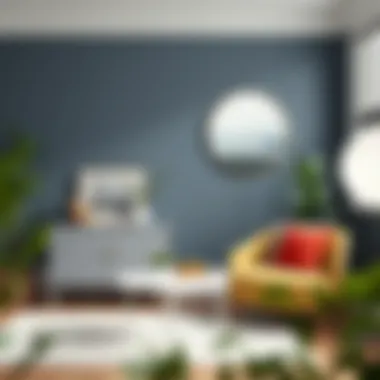
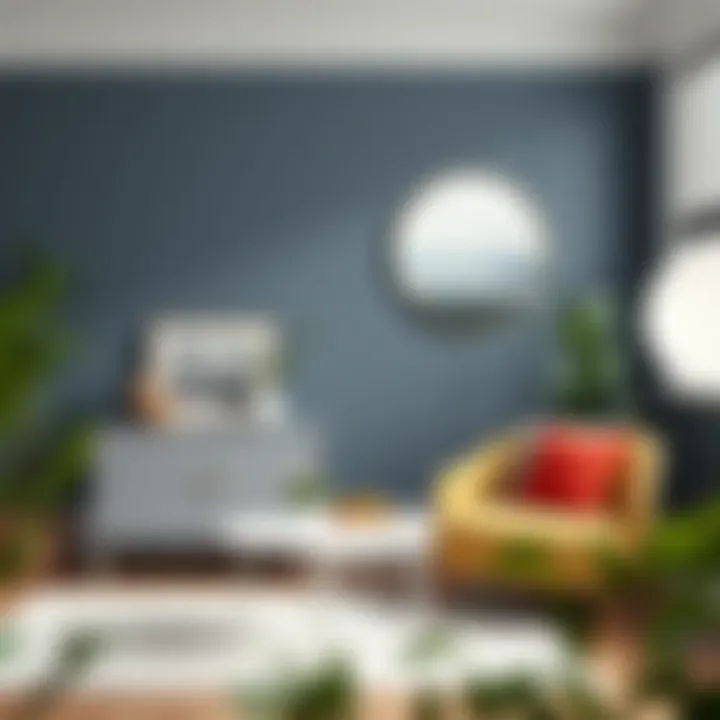
Combining with Other Colors
Accent Colors
Accent colors play a vital role in any design narrative. These hues not only compliment the primary color but also provide an eye-catching contrast or subtle enhancement that elevates the entire space. Incorporating Benjamin Moore's Color of the Year alongside accent colors can bring a room to life.
- Key Characteristic: Accent colors should be vibrant or distinctly different to create focal points in a room. For instance, pairing a rich green with a vibrant orange can invigorate a kitchen or a lively living area.
- Popularity and Benefits: They are popular due to their ability to break monotony, guiding the eye towards specific areas or features within a space.
However, balance is essential. Too many accents can dilute the intended mood. Hence, selecting one or two accent colors that resonate with the primary scheme ensures an appealing outcome.
"In design, simplicity is the ultimate sophistication. Less is often more."
Contrasting Palettes
Contrasting palettes can create dynamic and stimulating environments. These color schemes utilize opposing shades to make bold statements.
- Key Characteristic: Colors that stand on opposite sides of the color wheel, such as blues and oranges or yellows and purples, can create vibrant energy and visual interest, making any space feel alive.
- Benefits of Contrasting Choices: They serve as mechanisms to highlight specific features or zones in a room, whether it’s a striking wall or an architectural element. However, while contrasts can be exhilarating, it's vital to ensure that the juxtaposition feels intentional rather than chaotic.
Combining Benjamin Moore’s Color of the Year with contrasting hues can lead to remarkable interior narratives, if done carefully, providing stunning results that can leave guests in awe. Instead of merely decorating, one can paint a story with intentional, thoughtful choices in color.
Real-Life Applications of the Color of the Year
When it comes to interior design, the real-world applications of Benjamin Moore's Color of the Year offer significant insight into how color transforms spaces. The color serves not just as an aesthetic choice but also as a reflection of the homeowner’s personality and lifestyle. Understanding these applications can be beneficial for anyone looking to revamp their living areas or create a specific atmosphere.
The importance of this topic stems from how color influences not only the physical appearance of a space but also the feelings and responses it evokes in those who inhabit it. Incorporating the Color of the Year can breathe new life into tired rooms, similar to adding a sprinkle of fresh herbs to an old recipe. It's a way to rejuvenate an environment, fostering a sense of warmth, creativity, or calm depending on the hue selected.
Case Studies from Interior Designers
A practical examination of how experienced designers implement the Color of the Year can be revealing. Consider a project from New York-based interior designer, Lisa C. In her latest apartment renovation, she utilized Benjamin Moore's Color of the Year to redefine the living area entirely. The choice of a robust shade not only set the tone for the vibrant decor but also harmonized with natural light entering through the large windows. This smart selection enhanced depth and created a welcoming ambiance.
- Key Elements to Note:
- Light Reflection: Using the color strategically amplified daylight within the space.
- Focal Points: Accent pieces like a statement chair or artwork helped to emphasize the color, pulling the room together.
- Textures and Materials: Complementary materials, such as textiles and wood finishes, worked in conjunction to elevate the overall look.
Another notable case is a warm, earthy color chosen for a family kitchen in a suburban home by a lesser-known up-and-coming designer. This application not only resonated with the homeowners’ lifestyle but also reflects current trends toward organic and sustainable living spaces. The success of the space is attributed to its inviting nature, making it ideal for gatherings and family meals, showcasing the color's ability to unite function with coziness.
Homeowner Success Stories
Homeowners all around have also embraced the Color of the Year with great success. Take Lisa and Jamie from Austin, Texas, who decided to paint their master bedroom with last year’s hue. Feeling stuck in a rut, they wanted a color that would inspire good vibes and tranquillity. The result? A serene retreat that felt peaceful yet energizing. They incorporated soft white linens, wooden accents, and green plants, creating a harmonious blend.
Likewise, Mike and Sarah, a young couple from Seattle, transformed their home office by incorporating the color into their workspace. The rich hues helped stimulate creativity and focus, leading to increased productivity, and it also sparked conversations during virtual meetings. The contrast between the bold walls and their minimalist desk made for an appealing setup that highlighted the benefits of color in a workspace.
“Color is a tool that can change the way we feel in our spaces; it’s a silent communicator,” says interior design expert Mark Batman.
These stories emphasize how thoughtful choices in color selection can enhance daily life. As homeowners experiment with the Color of the Year, they not only personalize their spaces but also realize the profound impact color can have on mood and functionality.
In wrapping up, it's clear that real-life applications of Benjamin Moore's Color of the Year are rich with opportunities. As our case studies and success stories illustrate, residents and designers alike can navigate the complexities of color in practical, functional, and deeply personal ways.
Closure: Embracing the Color of the Year
As we wrap up our exploration of Benjamin Moore's Color of the Year for 2022, it's crucial to reflect on what this selection means for homeowners and design aficionados alike. Choosing a color isn't just about aesthetics; it's about crafting an atmosphere—one that resonates with personal style and psychological well-being. Each hue holds a narrative, serving as a backdrop for our lives and choices.
The Color of the Year signifies a trend that is more than a mere passing fancy. It's an emotional anchor, evoking comfort or inspiration within a space. For example, warm tones might invite relaxation in a living room, while cool shades can enhance focus in a home office. This year’s choice encourages us to indulge in our taste while also being mindful of how colors affect our moods and interactions.
"Colors are the smiles of nature." – Leigh Hunt
By incorporating the Color of the Year into our homes, we acknowledge design's significant role in shaping our environments. It's not just about slapping on a coat of paint; it's a thoughtful integration of design principles that enrich the living experience. Residents want spaces that reflect their personality, and the right color can anchor this sentiment deeply.
Future Predictions in Color Trends
Looking ahead, color trends are likely to continue their dance between tradition and innovation. Homeowners are becoming increasingly aware of how colors influence their daily lives, leading to a holistic approach in design. Future color selections may mirror the ever-evolving human experiences shaped by environment, technology, and sustainability considerations.
- Sustainable Choices: A major trend will be towards colors derived from natural sources. Expect hues that resonate with Earth, promoting a sense of calm and connection.
- Technologically Influenced Colors: As smart homes become the norm, color changing technology may influence newfound palettes that react to moods or time of day.
- Personalized Shades: Homeowners are likely to demand more individualized color solutions, leading designers to expand their curations and offerings.
In essence, embracing the Color of the Year not only reflects current trends but also paves the way for future dialogues about color, psychology, and personal expression. The thoughtful integration of the selected hue in our surroundings can meaningfully transform spaces, making it essential for both aesthetic appeal and emotional resonance.



